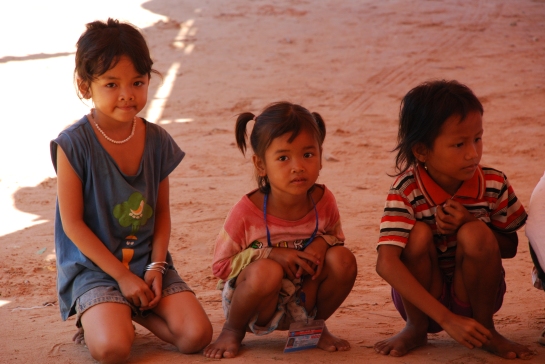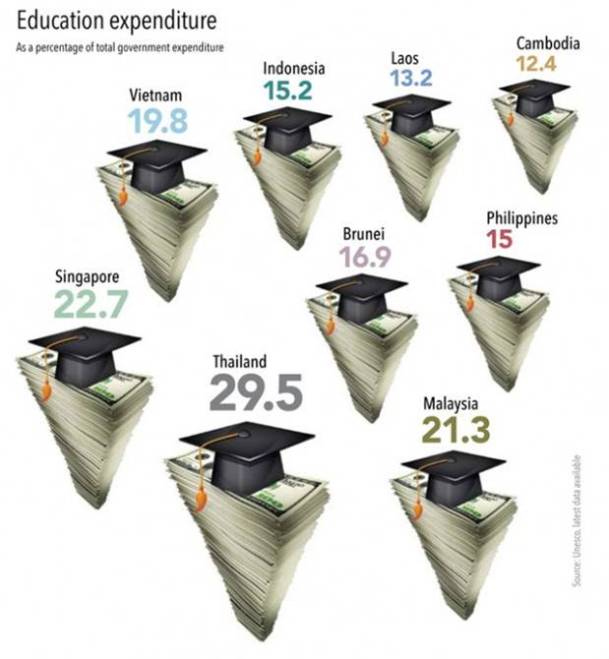When the Khmer Rouge were ousted from power in 1979, Cambodia was a mess. The school system was of course just one of the victims of the regime, so in hindsight it has been remarkable that the number of children enrolled at school in Cambodia has risen to levels as good – or better – than those of the 1960s.
Two things drive these numbers. One is the number of children, which since 1990 has burgeoned. On the population pyramid below, we can see a dent in the numbers amongst those aged 35 to 39. That reflects the greatly diminished birthrate, as well is the greatly increased child mortality rate of the Pol Pot years. But since then Cambodia has experienced one of the highest birth rates in the world, peaking around 1990, but retaining high levels since then, though with a small decrease 10 to 15 years ago. (Source: http://www.indexmundi)

Now let’s look at the school enrolments since 1980. If anything, the growth of these school enrolments has been faster than the growth of population. The reason for this is the investment by both the government as well as by NGOs in the building of schools, and the removal of barriers to education, particularly in rural areas that were ill served previously. I won’t get into detailed figures here, but if I take the cohort who were born 15 years ago, a greater percentage of those have been attending school than their equivalents from the cohort five or 10 years older.
Don’t be alarmed by the downturn in the chart below. The recent decrease in primary school enrolments, is population driven, reflecting (as I mentioned above,) the recent decrease in birth rates 5 to 15 years ago. However numbers are expected to pick up again, judging by the figures in the population pyramid.
The chart below (based on MOEYS figures,) shows dramatically the overall rise in school enrolments since 1980, yet it shows just as dramatically the relatively skinny percentage of those enrolments that are occurring at upper secondary school level: grades nine through to 12.

Cambodia faces challenges at each level of the education system.
Pre-School Right now, and not betrayed the figures above, is the challenge of introducing more preschoolers into the education system. The aim of this is to give these children a head start with reading, writing and social skills.
Primary School At the primary school level, as the chart above suggests, we appear to be at a moment of reprieve, whereby the available resources can be shared out amongst fewer children than previously experienced. However the primary schools sector is in the state of crisis at present because it is losing teaching staff rapidly. The reason for this is the historically poor levels of remuneration available for teaching staff. Many teachers are switching from primary to secondary schools in order to get more liveable wage.
Secondary School At the lower and upper secondary school level, there are several problems still. While teachers are highly regarded, and are on salaries that are comparatively generous – comparatively that is – there is still a shortage of trained teachers, and a terrible shortage of resources such as textbooks, science equipment and even such basics as whiteboard markers. By world standards the Cambodian government is a poor investor in its own education system. According to UNESCO figures, (2011)13.1% of government spending goes to education – skinny slice of the small pie.
From the perspective of Savong school in Bakong, Siem Reap, we can see how we have fitted in to the broad narrative of the post 1980 story. I think it is important for NGOs to keep evaluating their own role within the wider picture. Right now, Savong is examining the role of the school which works around the local secondary schools. They operate in the mornings, and so during those same mornings Savong’s School remains empty. The plan, due to be rolled out in October this year is to utilise the teaching and physical resource of the school in order to provide local rural students primary education services. This is quite apart from the language and computer teaching that his school already provides to senior students currently in grades 6 to 12.
For more facts and figures about the Cambodian education system:







You must be logged in to post a comment.